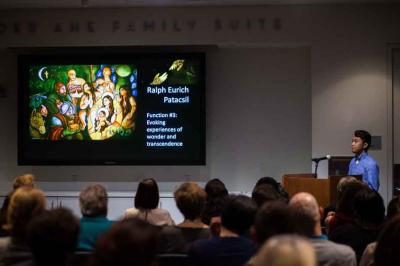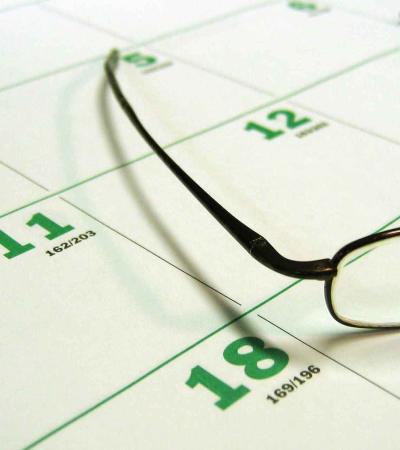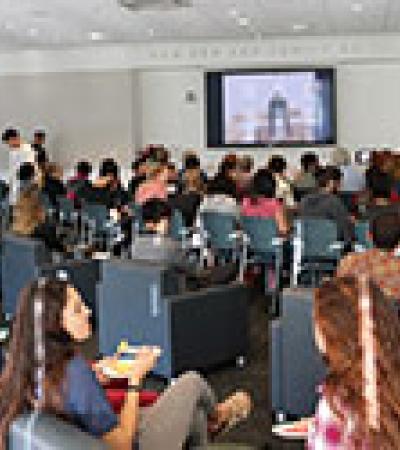Last year, I wrote about how you can use conditional formatting in Excel to track important deadlines for promoting library programs. In order to ensure that I remember to send something out to the more than 14 communication channels that we routinely utilize at the William H. Hannon Library, these customized spreadsheets have been indispensable.
Following the publication of that post, I was contacted by a number of Programming Librarian readers seeking more information about the specific channels that we use — some of which can be seen in the screenshots from the original post — and how we prepare information for each of those outlets. The following provides a brief outline of each step in my communications plan for library events.

Six to eight months out: Getting it on the books
Not all programming work begins this early, but I usually have a good idea of what our calendar will look like at least six months in advance. Like many universities, there is no lack of campus programming for students, faculty and staff, and scheduling events on top of each other is unavoidable. That said, having our events on the calendar as soon as possible helps us to prepare for those moments when other large events on campus threaten to impact turnout at the library.
There are four main calendars that we attempt to synchronize:
- The Outreach Department's internal Outlook calender
- The university's primary events calendar (powered by Localist)
- The main student events calendar (powered by OrgSync)
- Our RSVP form calendar (powered by LibCal)
Getting an event posted to each of these spaces requires me to have certain information publication-ready. For example, by this point I need to know:
- the date and time of the event
- the official title
- the location (which requires reserving the space on campus)
- a brief one or two paragraph description
- whether or not we are collecting RSVPs (in which case, a web form must be developed)
- a list of co-sponsors (so they can be tagged in Localist)
Knowing that I need this information prepared six months ahead of time just to get the event on the calendar helps me to make decisions about the essential details far enough in advance.
Four to six months out: The silent phase
It's still too early to do a concerted promotional push for most of our programs at this point (see also: campus events overload), so between four and six months out I enter into what I call the "silent phase" of program planning. This is the moment when we work with our partners to further refine the details of the program, including set-up, schedule, desired deliverables, outcomes, and perhaps more importantly, our target audiences.
On a university campus, our target audiences essentially fall into three categories: faculty and courses, student groups, and key leadership. For each of these categories, I create a list of our top three targets and the name of who will be responsible for reaching out to them about the program once we are ready to spread the word.
Two to four months out: Design all the things
Once we have identified our target audiences, I can begin working on the promotional materials. During this time, I work with our student graphic designer to develop fliers, posters, web banners, digital signage graphics and other deliverables that are necessary to promote the event.
This is also, I have found, the ideal time to invite key leadership who often cannot commit to anything more than four months in advance but also need a couple months notice in order to get anything on their calendars.

One to two months out: The coming communications storm
Now the communications and outreach barrage really begins.
Those target audiences we identified two months ago? This is when my team and I begin reaching out and inviting them to our program (by email, phone, office visit, chocolate, whatever works). This is also the time when I reach out to the communications director from any department who might be co-sponsoring or have a faculty member participating in our event so they can work their channels on our behalf. Since our deliverables are complete, I am also sharing those files with them.
If I haven't already done so, this is also my deadline for publishing information about the program in our monthly newsletter, on the library's blog and to our Facebook page's Events section (yes, we still do that).
The final communications push
By this point, if I have followed all the previous steps, the communications plan is on auto-pilot. I can re-use all the content and deliverables created earlier to make a last-minute push to remind students and faculty about our upcoming program. Specifically:
- Two weeks out: Post about the event to Twitter, Facebook, Instagram and Snapchat; send digital deliverables to university's Marketing & Communications team to promote on the university's main social media channels; and email reminder about the event to library staff.
- Three days out: Email a reminder to anyone who has RSVPed for the event.
- One day out: Post about the event to Twitter. (It's worth mentioning at this point that our Twitter feed is embedded on our library's webpage, so it's always the most current information that our users see, hence our over-reliance on it as a communications channel.)
- Day of: Post a final reminder to Twitter prior to when the event begins.
- While the event is happening: Live-tweet or post to Instagram Stories as appropriate.
Follow-up communications: Library events never really die
Of course, promoting the event doesn't end when all the guests have left. There is still more you can do via your communications channels to get the most out of a library program and to encourage library users (even those who did not attend your event) to come to future programs.
- Day after: Post a photo to Instagram to remember a key moment from the event; write thank-you notes to our program partners and any key VIPs who attended.
- One week after: Post a remembrance on Twitter or Facebook (ideally with a photo); process any feedback we received while it's fresh in our minds.
- One month after: Process and share all our photos on Flickr; publish a summary of the event to our library's website, blog or newsletter (this semester we enlisted our student workers to help us with this!); and complete our executive summary.
There you have it. In an ideal world, that is the communications cycle that I use for every library program. Obviously, I skip steps from time to time, and other programs are far more intensive, but this is a good standard that has worked well for us. Since developing this schedule, we've seen a steady rise in attendance numbers and fewer "needed more advertising" comments on our feedback forms.



